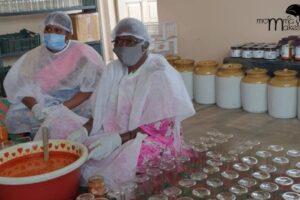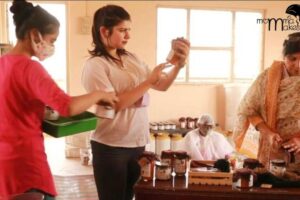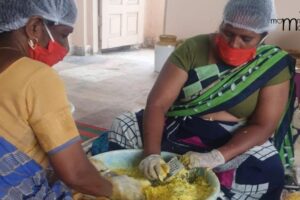About Us

About us
‘Momma Makes’ is a mother-daughter duo which started out with a small idea being Discussed within the family for a few years , those discussions bore fruit during the pandemic when as a family – Mom, my siblings & me finally ran out of conversation.
First order of the day was to think of a brand name after debating for a few days the eldest of the siblings whose patience was running low simply suggested ‘ since Momma is making all of it , Let’s just call it Momma Makes ‘
Somehow all of us loved the sound of it and ‘Momma Makes’ was born.
Women Run Organisation
Apart from just being a mother-daughter organisation we pride ourselves in being an all women run organisation
This started since our inception during the pandemic where our initial range of products required a lot of handy work. That’s when our house help came to the rescue & told us about a lot of women in the locality who were unemployed & finding it difficult to make ends meet.
Since then Momma Makes has been an all women run organisation. Be it our founders, inhouse staff or external resources who asist us from time to time.
Origin of Sindh
Sindh originally was a part of India, which during the partition became one of the four provinces of Pakistan and historically home to the Sindhi people. The name of Sindh is derived from the Indus River that separates it from Baluchistan and the greater Iranian Plateau. In Sanskrit, síndhu means “river, stream”. The Greeks who conquered Sindh in 325 BC under the command of Alexander the Great rendered it as Indós, hence the modern Indus. When the British arrived in the 17th century, they followed that regional.
Sindh flourished between the 25th century BC and 1500 BC in the Indus valley sites of Mohenjo-Daro and Harappa. This indigenous civilization collapsed around 1700 BC. Skeletons discovered in the ruins of Mohenjo-Daro (“mount of dead”) indicate that the city was suddenly attacked and the population was wiped out.
Post the partition, the Sindhi community that chose to remain in India, were distributed among various relief camps spread across the western regions. Most prominent of these sites were Ulhasnagar, Pimpri (Pune), Nasik, Rajkot, Indore, etc. This community made these camps their homes and re cultivated the ancient traditions & cultures, which are still very alive in these pockets.
Significance of Ajrak
When the world is buzzing with “sustainability” and “environment-friendly” as the newest big trends of the future, for many centuries, innumerable crafts have existed in harmony with nature. Some things so subtle that they do not glare out, yet so vivid that one cannot help but appreciate the aesthetics in their creation. One such craft is the Sindhi Ajrak.
Traditionally, Ajrak is the name of a block printed cloth with deep crimson red and indigo blue background, bearing symmetrical patterns with interspersed unprinted sparkling white motifs. An ancient craft, the history of the Ajrak can be traced back to the civilizations of the Indus Valley that existed around 2500 BC-1500 BC.
The term “Ajrak”, may be derived from “Azrak”, meaning blue in Arabic, as blue happens to be the one of the principal colours in Ajrak printing. More than a fabric, Ajrak is a Sindhi tradition; found in daily usage such as hammocks and bedsheets to duppattas, scarves, and even gifts as a token of respect. The highly valued Ajrak has also been made in Kutch for the Maldharis or cattle herders’ communities since the time Khatris migrated from Sindh in the 16th century. The Khatri community, whose name means “one who fills or changes colours,” printed cloth with the locally available natural dyes and water from the Dhamadka, the river that gave their village its name.
THE ANCIENT Potli Achar
The Sindhi community is known for its pickles since centuries as each family would carefully preserve and hand down their receipies to the next generation. Of all these Pickles the Potli Achaar has been the most favored, simply for its exotic blend and ease of use. Hand picked raw mangoes would be grated and mixed with a blend of spices like fenugreek seeds, fennel, pepper corns, etc with a dash of mustard oil. This mix would then be tightly tied in muslin cloth with a clove of garlic each and soaked in a mix of water – vinegar – mustard oil to ferment. What resulted from this process was a perfect golden blend of grated mango pickle that was aromatic and full of flavour, ready to eat as is or as an accompaniment to any meal.
Traditionally this pickle was designed in potlis for ease of carrying it during travel, since the community consisted mainly of traders who were always on the move. With changing times & decades later, this pickle is now available minus the potli for you to savour with your family.
Sindh In A Jar – The same great tasting potli achaar, mixed using authentic Sindhi spices hand ground with love. Enjoy the tantalising taste seeped in culture & heritage from the ancient Land of Sindh.
Our Story
India has a lot of Sindhi pockets spread across the length and breadth of the country, of which perhaps the most established colonies is the one in Ulhasnagar, Mumbai. If one thing, the Sindhi community is known for, is its food & culture. But sadly enough, being here for over four generations the youth has now slowly adapted to the native foods & cultures thereby forgetting age old habits & family recipes
I’ve had the good fortune of being a first-generation Sindhi, as my mom was born & grew up in Sindh moving to Ulhasnagar only after marriage. Coming from a family seeped in traditional values & culture she has always had a flair for cooking the best the Sindhi culture has to offer. One of my favourite child hood memories have been those of my granny visiting during mango season, where fresh handpicked raw mangoes would come into the house and everyone would sit together grating them, followed by a detailed mixing process in large martabans (Large Earthen Pickle Jars) . What would follow after that would be a host of relatives lining up to claim their share of this pickle that I later learnt is as ancient as the Sindhi community itself, specially because it would always be made using traditional spices from Sindh, which would come every time my granny visited.
All through school I remember all my friends would wait patiently, for me to open my tiffin and grab bits of the achaar during the lunch break; and this continued even in college where friends would always drop in to savour mom’s cooking accompanied with a variety of traditionally made achaars.
Business being in the blood of every Sindhi Child, I’ve been no less and when it came down to figuring what direction to take, all I could think of was exposing the world to our glorious culture & cuisine. The strongest of all memories being the raw mango aachar, we decided it would be best to launch with that and thus Sindh in a Jar came to form. With Mom at the helm of the mixing and my 2 elder siblings, who have always had my back, guiding & correcting me, what followed was numerous trials & sampling exercises, among friends & family, whose valuable feedback helped design the look and feel of the packaging to reflect our glorious culture & tradition. For me personally, Sindh in a Jar is not just a brand but a labour of love.
We are now available in a variety of stores & online too. I invite you to come savour, authentic flavours from The Land of Sindh.

Become a Retailer or a Distributor
Thank you for your interest in stocking or distributing Momma Makes products.
We request you to kindly send us your details, for us to learn more about your business before we can proceed with a formal application. We can only assess applications for business that are already open and trading.




